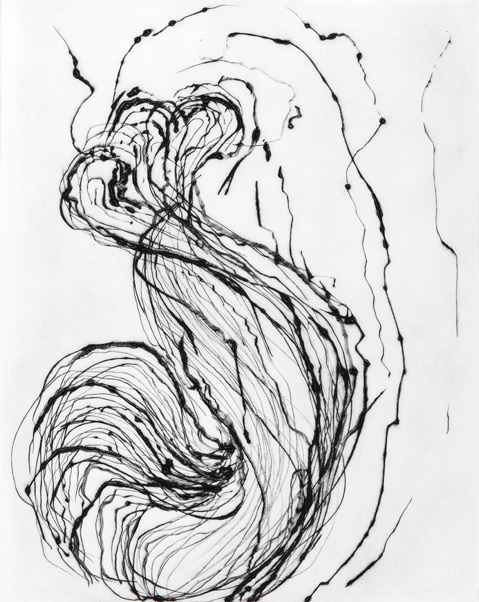Marie Schoeff, Traces at Jane Deering Gallery
New Show Combines Drawing and Printing in Unusual Ways
The loose and layered three-dimensional whorls at the heart of Marie Schoeff’s current work repeat a fundamental gesture that seeks to recapture the sensuality and integrity of the human body. Whether they refer to the female figure, to plants, flowers, and fruit, or to the shapely and sensuous mental spaces of intimacy, Schoeff’s marks only suggest specific images, remaining abstract, although they bear witness to the hand of the artist and the vicissitudes of the process and the media. From the evidence of this show, with its seven drypoint prints and dozen “trace drawings,” Schoeff has been very active with the press in the last two years. Many of the pieces on view have complex and vivid histories involving multiple encounters with plexiglass, ink, paper, and pressure.
The Trace Drawing series represents Schoeff’s original contribution to the history of the print, as they exist by virtue of a sequence of procedures that, in this combination at least, are wholly the artist’s own and that result in a two-sided art object that resists easy assimilation into known categories of print or drawing. Schoeff draws on the exposed side of a sheet of paper while the inked plexiglass plate sits below her drawing surface, marking the far side of the sheet. Then, when the print is pulled, what’s underneath shows up as a negative of the image on top, as the pressure of the drawing on the surface evacuates lines of white from the print below. There are also all kinds of incidental effects due to the presence of air bubbles and dust. This side of the drawing is the trace, and it provides a ghostly reminder of the double life that any image leads in the age of mechanical reproduction.

The results of this immersion in the printing process are uniformly satisfying and deep. Drypoints like “Mommy Long Legs” and the “Coils,” “Second,” and “Third” have the edgy intensity of black-and-white prints and the jazzy immediacy of ink-and-brush drawing. The delicious feathered edges of these sinuous lines are effects achieved at one remove from their source, having begun as the marks left in plexiglass by the passage of Schoeff’s etching tool, which is a hot soldering iron. Only later when the burrs created by this method of making incisions in the plastic are filled with ink do they flow on and into the paper, creating the slight fuzziness that gives these compositions their unique texture and added dimensionality.
Schoeff’s mastery of form comes out over and over again in the trace drawings, which are the show’s main attraction. These two-sided works reveal an aesthetic sensibility that’s equally at home with the organic and the mechanical, hatching a seemingly endless proliferation of self-englobed surfaces through the interaction of print, hand, and ink. In the sequence of trace drawings that begins with “Spinner” and goes through “Ghost Spinner,” “Duomo Duo,” and “Duomo Ghost,” Schoeff demonstrates the richness and intricacy of detail that becomes possible when these techniques are deployed in a kind of relay, where one print becomes the basis of the next, and so on. To really appreciate the exquisite balance and authority of these works, you really have to see them in person, where the play of surface and depth evoked by the artist’s draftsmanship becomes as one with the medium. Congratulations to the Jane Deering Gallery for kicking off 2012 with such a rewarding and elegant exhibit.
4•1•1
Marie Schoeff’s Traces runs through January 29 at the Jane Deering Gallery, 128 East Canon Perdido Street.



